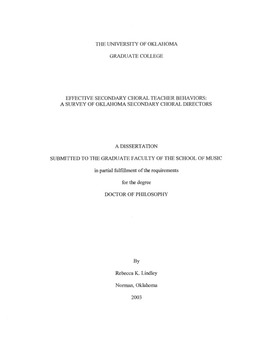| dc.contributor.advisor | Barry, Nancy, | en_US |
| dc.contributor.author | Lindley, Rebecca Kay. | en_US |
| dc.date.accessioned | 2013-08-16T12:19:01Z | |
| dc.date.available | 2013-08-16T12:19:01Z | |
| dc.date.issued | 2003 | en_US |
| dc.identifier.uri | https://hdl.handle.net/11244/622 | |
| dc.description.abstract | The data collected helped provide an overview of behaviors that secondary public school choral teachers believe could be used in a music teacher assessment tool. | en_US |
| dc.description.abstract | The following research questions were considered throughout the investigation: (a) What are important instructional behaviors that secondary public school choral music teachers in the state of Oklahoma believe should be included in a secondary choral music teacher assessment tool? (b) Is there a difference of opinion on important instructional behaviors between secondary public school choral music teachers based on years of experience? (c) Is there a difference of opinion on important instructional behaviors between teachers in rural and urban districts? (d) Is there a difference of opinion on important instructional behaviors between secondary public school choral music teachers teaching at the following levels: Mid High 9th--10 th grades, Senior High 11th--12th grades, Middle School 6th--8th grades, Junior High 7th--9th grades, and High School 9th--12th grades? (e) Is there a difference of opinion on important instructional behaviors between secondary public school music teachers from small schools and music teachers from large schools? (f) Is there a difference of opinion on important instructional behaviors between secondary public school choral music teachers of varying ages? and (g) Is there a difference of opinion on important instructional behaviors between male and female secondary public school choral music teachers? | en_US |
| dc.description.abstract | The purpose of the study was to identify effective secondary choral teacher behaviors that could be used in a choral teacher assessment instrument. Participants were 180 secondary public school choral teachers from the membership rolls of the Oklahoma Music Educators Association. | en_US |
| dc.description.abstract | The survey was drawn from the music education research base and was piloted for content validity. Descriptive statistics, cross tabulations and Pearson Chi Square statistics were used for data analysis. Cronbachs Alpha was employed to determine reliability of item clusters. Data analysis showed several behavioral commonalities among the survey participants as well as three areas of significant difference. Those areas were "use of technology in the classroom", "written lesson plans for every class", and adjudicated performances used for teacher assessment". Secondary public school choral teachers preferred behaviors that relate directly to inter-acting with students as opposed to behaviors that deal with paperwork. | en_US |
| dc.format.extent | ix, 137 leaves : | en_US |
| dc.subject | Education, Music. | en_US |
| dc.subject | Education, Secondary. | en_US |
| dc.subject | Music teachers Oklahoma. | en_US |
| dc.subject | Music in education Oklahoma. | en_US |
| dc.subject | Choral conducting Study and teaching (Secondary) | en_US |
| dc.title | Effective secondary choral teacher behaviors: A survey of Oklahoma secondary choral directors. | en_US |
| dc.type | Thesis | en_US |
| dc.thesis.degree | Ph.D. | en_US |
| dc.thesis.degreeDiscipline | School of Music | en_US |
| dc.note | Source: Dissertation Abstracts International, Volume: 64-06, Section: A, page: 2018. | en_US |
| dc.note | Chair: Nancy Barry. | en_US |
| ou.identifier | (UMI)AAI3094293 | en_US |
| ou.group | Weitzenhoffer Family College of Fine Arts::School of Music | |
